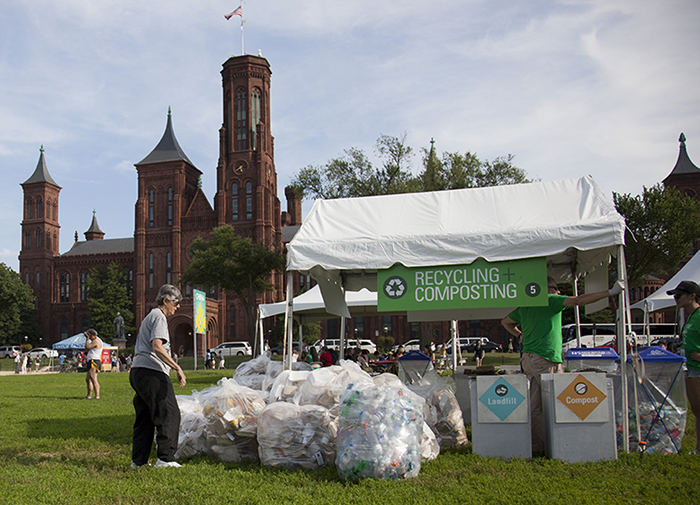Sustainability Matters: Week One Stats on Waste Diversion

Have you noticed the resource recovery stations at the Folklife Festival, with bins for compost, recycling, and landfill waste? Have you noticed that the landfill bins are always nearly empty?
At the Festival we are committed to sustainability, working with food vendors and visitors in minimizing our environmental footprint. So far, during the first week of the Festival—and including the Smithsonian staff picnic on the Festival grounds on Tuesday—we have broken our records in diversion efforts.
Total waste collected: 23. 6 tons
Composted: 12.5 tons
Recycled: 9.2 tons
Total diverted from landfill: 91.8%
The 2013 Festival was our first in offering both recycling and composting options. Over the two weeks, we diverted approximately 74 percent of waste, including 20 tons of compost and 16.5 tons of recyclables. This year we have required our food vendors to use entirely compostable wares, from sugarcane fiber clamshell boxes to corn and potato starch forks. Even cooking oil from the concessions is collected to process into biofuel.
Some of the materials are recycled on site, as Kenyan artists from Kitengela Glass are building a small hut out of beer bottles from the concession stands. Vinyl signs from Festivals past have been recycled into sturdy tote bags for sale in the Marketplace.
Eric Hollinger leads our sustainability team, a diversion—although not unrelated—from his regular job as an archeologist at the National Museum of Natural History. “I study trash for a living!” he says. He described the Festival grounds as an archeological site, where we can learn about human habits through what they leave behind.
“We’re continually observing and thinking of how to improve things,” he says.
As we talked with sustainability interns Ridley Vann and Sarah Gaines, on assignment from the Smithsonian Office of Facilities Management and Reliability, they started brainstorming how to cover up the National Park Service trash cans in the future so that more waste can be properly sorted in our bins. They said that already visitors from other organizations and festivals, including the D.C. Green Festival and Arlington County, have been asking for advice based on the success of our sustainability efforts.
If you are interested in volunteering with the sustainability team this week, contact volunteer coordinator Becky Squire at SquireR2@si.edu.
Elisa Hough is the editor for the Center for Folklife and Cultural Heritage and self-appointed trash sorter for the audio/visual documentation office trailer.

